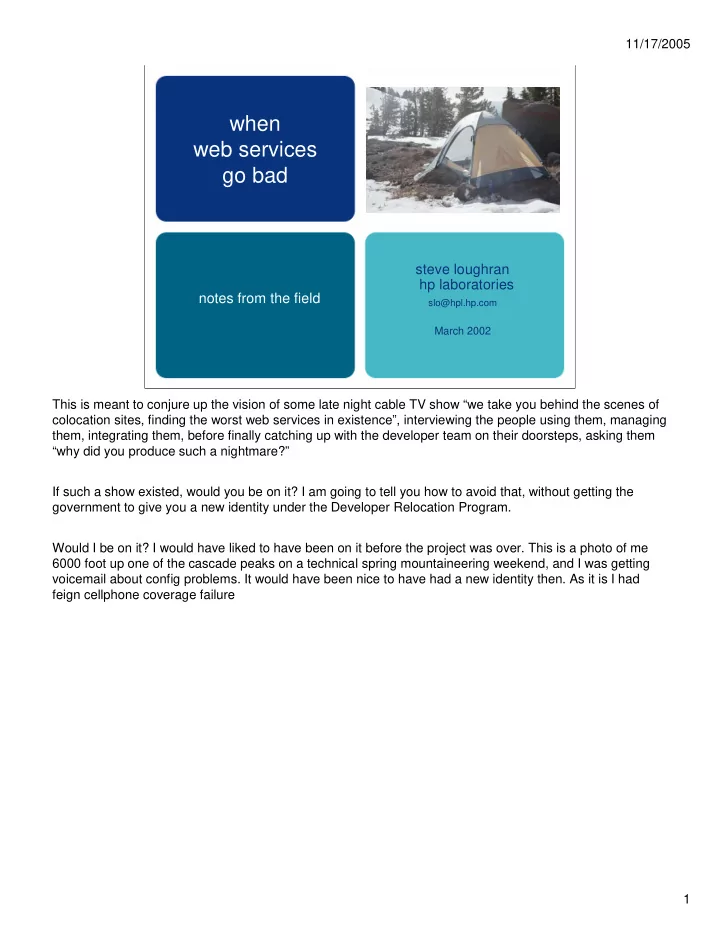

11/17/2005 when web services go bad steve loughran hp laboratories notes from the field slo@hpl.hp.com March 2002 This is meant to conjure up the vision of some late night cable TV show “we take you behind the scenes of colocation sites, finding the worst web services in existence”, interviewing the people using them, managing them, integrating them, before finally catching up with the developer team on their doorsteps, asking them “why did you produce such a nightmare?” If such a show existed, would you be on it? I am going to tell you how to avoid that, without getting the government to give you a new identity under the Developer Relocation Program. Would I be on it? I would have liked to have been on it before the project was over. This is a photo of me 6000 foot up one of the cascade peaks on a technical spring mountaineering weekend, and I was getting voicemail about config problems. It would have been nice to have had a new identity then. As it is I had feign cellphone coverage failure 1
11/17/2005 global distribution +global load +expectations of “web speed” why is it so hard? development +http at the bottom web service +integration with remote development = callers +service level agreements covering QoS = a new set of a problems! Those who are about to deploy, we salute you! None of the aspects of web service dev are new to the software world; talk to anyone doing telecoms software and hear about their problems -then listen to their processes for testing for three months before product releases. What is new is that everyone is being encourage to join in, and the integration problems harder while the underlying protocols are still evolving. Previous projects like ‘a global CORBA based application with dynamic service location’ was clearly left to the experts (and even then success was a bit hit and miss) 2
11/17/2005 image storage and SVG rendering service XML-RPC User Agent Front End servlet xmlrpc xmlrpcsaxhandler svgstore renderer post() doPost(request:HttpRequest, response:HttpResponse) 1. POST SVG in execute(xml:String) parse(xml:String) payload Message5() createReference(user:int) Message7() 2. render to JPEG render() Message9() Message10() 3. return URL Message11() page() doGet(request:HttpRequest, response:HttpResponse) doGet(request:HttpRequest, response:HttpResponse) 4. user fetch doGet(request:HttpRequest, response:HttpResponse) image() or print on press +1TB image store for customer photos So here is what we did as a service. It is almost your definitive “easiest RPC mechanism ever” example – idempotent RPC calls, one method “render this XML for that person”, returning either a URL or an error string. As far as implementation goes, this is “my first use case”class of RUP, which is good as we used “my first UML modeler”, visio, to host the design and crank out the framework. Easy Huh? This a) made it nearly viable on the timescales marketing made up at random and b) meant all the problems we had were more related to deployment than RPC stuff. 3
11/17/2005 • SLA: high availability • render times: constraints 2s proof render 15s production basic asset store done: • XML-RPC agreed on -SQL server RPC mechanism IIS/ASP • wildly optimistic COM/MTS->Win2K/COM+ timescales “real soon now” Here are some of things that we had to meet to satisfy the customer. -High Availability is universal; you want to use a web service you expect it there all the time. We had the basics from the colocation service of twin power plants and the like; it was up to us to ruin their availability promises. -The render times are an interesting one. SVG can be used for insanely complex graphics; the 2 sec is for the expected use (photo album) and under ‘normal’ load, not peak. Even then, it was a tough one. We were given the basic asset store “proven technology” from another part of the company who had built it and put the deal together. This probably created more issues than anything else. By the time we realised what a mess it was, it was too late to fix. XML RPC was the already agreed on mechanism. This had two main flaws for us –you cant pass XML inside it unencoded, and the exception specification is very weak. But it worked and took two days to implement, which cant be bad. Timescales. Team convened feb, first deliverable march, early june for live, second phase late Aug. This could have been viable if the asset store was robust enough. Actual timescales: live in August, phase II in Jan ’02…partially because phase I worked so well there was no need to upgrade, also because Xmas was the busy time… The customer is actually a ‘strategic account’, which means that if they aren't happy their CEO calls our CEO, and voicemails trickle down to us. This used to cause a lot of grief, but now we can all say what project we worked on and anyone up the entire management chain takes a step back and goes “oh, that project”. At the time it meant that if we screwed anything up, everyone got to know of it. 4
Recommend
More recommend